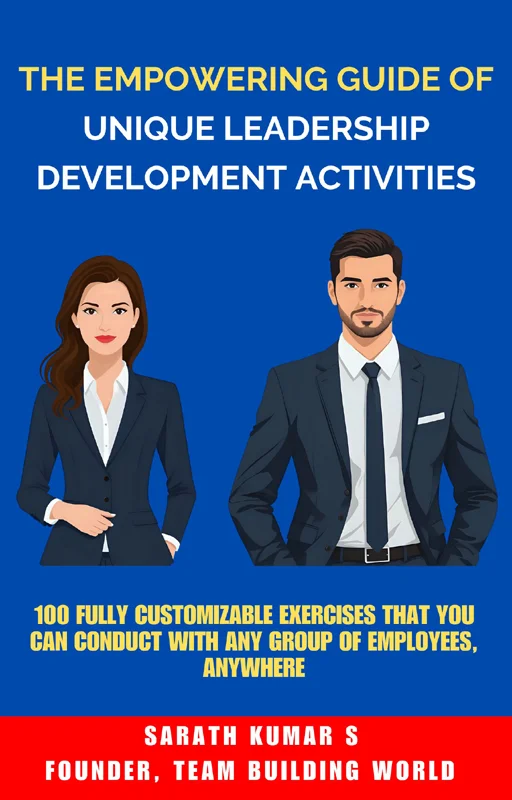10 Leadership Team Bonding Activities for the Workplace
Are you in search of some leadership team bonding activities for the workplace?
As an organizational leader, building and maintaining a strong bond with your team is crucial for a successful work environment. That’s why you need the right set of activities to help your team connect, communicate, and collaborate effectively.
In this article, let’s see 10 activities that can help your leadership team bond and become a more cohesive unit.
Why is Leadership Team Bonding Important?
Team bonding is an important aspect of creating a positive work culture and promoting collaboration within a group. When members of a leadership team have a strong bond, they are more likely to communicate effectively, trust one another, and work together towards common goals.
Additionally, bonding activities provide the opportunity for leaders to get to know each other on a personal level, leading to better understanding and empathy among group members. This can also improve overall job satisfaction and reduce turnover in the workplace.
10 Leadership Team Bonding Activities for the Workplace
Here are some activities that can help leaders in your organization bond and strengthen their relationship with each other.
#1. Visionary Leadership Exercise
This activity helps leaders refine their ability to inspire others by creating and communicating a compelling vision. It emphasizes strategic thinking, storytelling, and alignment with organizational goals.
Time: 15-20 minutes
Materials: Vision statements, strategic maps, and discussion prompts
Participants: Any number of people per group
Instructions
- Provide each team with a vision statement or strategic map of the organization.
- Ask them to brainstorm and discuss how their individual roles contribute to the overall vision.
- Encourage the leaders to create an inspiring story about their role in achieving the organizational goals.
Debrief
Discuss how leaders can effectively align their actions and decisions with the company’s vision, values, and objectives. Reflect on how clear communication and collaboration among teams can lead to a shared understanding and commitment towards a common goal.
You can also read: 14 Team Bonding Ideas to Promote Spirit in Your Workplace
#2. Trust Walk
This activity helps build trust within the team by relying on communication. It also improves teamwork and problem-solving skills.
Time: 10-15 minutes
Materials: Blindfolds
Participants: Groups of 2 people
Instructions
- Ask each team to choose one member to be blindfolded and the other to act as a guide.
- Instruct the blindfolded team member to trust their partner to lead them through an obstacle course without any verbal communication. Examples: Navigate through a maze of chairs, walk across a designated path taped on the floor, or find their way around a room with scattered objects.
- The guide can communicate through gentle touches or hand signals to navigate their partner safely.
Debrief
Discuss the importance of trust, effective non-verbal communication, and the role they play in teamwork and leadership. Reflect on how this activity relates to situations in the workplace that require trust and clear communication, such as delegating tasks or relying on colleagues for support in challenging projects.
You can also read: 10 Spiritual Team Building Activities for the Workplace
#3. Innovation Brainstorming Session
This activity encourages leaders to think creatively and collaboratively to solve complex problems or generate new ideas. It inspires innovation and strengthens decision-making skills.
Time: You decide
Materials: Whiteboard, sticky notes, or digital brainstorming tools
Participants: Entire leadership team
Instructions
- Present a current challenge or opportunity faced by the organization.
- Give the team time to brainstorm individually before coming together to share their ideas.
- Use brainstorming techniques such as mind mapping, “What if” scenarios, or SCAMPER (Substitute, Combine, Adapt, Modify, Put to another use, Eliminate, Reverse).
- Combine similar ideas, evaluate their feasibility, and prioritize the best solutions for further development.
Debrief
Highlight the role of collaboration and creative problem-solving in driving innovation. Reflect on how encouraging diverse perspectives can help tackle challenges and uncover unique opportunities.
#4. Leadership Roundtable
This activity encourages team members to share ideas and experiences. It fosters open communication, trust, and mutual understanding.
Time: 15-20 minutes
Materials: None
Participants: Entire leadership team
Instructions
- Arrange seating in a circular format so that everyone feels included and can easily participate.
- Present a relevant leadership topic or challenge for discussion, such as navigating workplace conflicts, improving team morale, or adapting to organizational change.
- Give each team member the opportunity to share their thoughts, experiences, and suggestions around the chosen topic.
- Encourage active listening and respectful dialogue by setting basic ground rules for interaction.
Debrief
Discuss the key takeaways from the conversation, emphasizing how diverse perspectives can lead to more effective decision-making. Reflect on the importance of fostering open communication in the workplace and how it can enhance collaboration, build empathy, and strengthen leadership dynamics.
You can also read: 10 Leadership Team Building Exercises (With Debrief)
#5. Escape Room Challenge
This activity requires teams to work together to solve puzzles and escape a locked room. It promotes problem-solving, communication, and teamwork.
Time: 15-20 minutes
Materials: Escape room kit or online escape room game
Participants: Groups of 4-8 individuals
Instructions
- Divide your leadership team into smaller groups and assign them to different escape rooms (physical or virtual).
- Provide each group with the necessary information and tools to solve the puzzles and escape the room within a set time limit.
Debrief
Discuss how the teams worked together, what strategies they used to solve problems, and how individual strengths contributed to the success of the group. Reflect on how these skills can be applied in a work setting, such as working with cross-functional teams or managing challenging projects.
#6. Personality Insights
This activity helps participants understand their own strengths, weaknesses, and working styles while learning to appreciate diversity within the team.
Time: You decide
Materials: Personality assessments, and discussion prompts
Participants: Groups of any size
Instructions
- Provide each team member with a personality assessment tool, such as the Myers-Briggs Type Indicator or the DISC assessment.
- After that test, encourage them to share their results. Then, they can discuss how their unique traits and preferences influence their behavior, communication, and decision-making.
- Facilitate a discussion on valuing diversity and utilizing different strengths within the team for better collaboration.
Debrief
Discuss how understanding different personalities can improve communication, conflict resolution, and overall team dynamics in the workplace. Reflect on how leaders can leverage this knowledge to build stronger relationships with colleagues and foster a positive work culture.
#7. Creative Collaboration Project
This activity puts leaders’ creativity and teamwork to the test through a collaborative project. It fosters innovation and strengthens connections within the group.
Time: You decide
Materials: Art or craft supplies, presentation tools, or digital collaboration platforms
Participants: 3-6 members per group
Instructions
- Assign a creative project, such as designing a product prototype, creating an advertising campaign, or developing a team logo.
- Provide the necessary materials and a deadline to complete the project.
- Have each group present their final work to others.
Debrief
Discuss the creative process and the teamwork involved in completing the project. Highlight the importance of combining skills and ideas to achieve innovative solutions in the workplace.
#8. Active Listening Workshop
This activity focuses on developing active listening skills, which are essential for effective communication and leadership. It helps leaders build empathy and establish stronger connections with their team members.
Time: 15-20 minutes
Materials: Roleplay scenarios, and discussion prompts
Participants: 2-8 members in a group
Instructions
- Begin with a short presentation on the principles of active listening, such as maintaining eye contact, avoiding interruptions, and summarizing what has been said.
- Divide the participants into pairs or small groups to practice active listening through roleplay or discussion-based activities. Assign scenarios where one person shares an issue or idea, and the other practices active listening to respond appropriately.
- Encourage the participants to provide feedback to their partners on how effectively they listened and engaged.
Debrief
Discuss how improved listening skills can enhance team communication, resolve conflicts, and foster a supportive work environment. Highlight the importance of being fully present in conversations and validating others’ perspectives as key components of effective leadership.
#9. Scavenger Hunt
This activity promotes problem-solving, communication, and collaboration. It also encourages leaders to have fun and bond outside of the workplace.
Time: 10-20 minutes
Materials: A list of items
Participants: Groups of 3-8 individuals
Instructions
- Create a list of items or clues for teams to find within a specific area.
- Assign each team a starting point and provide them with the list.
- The first team to complete the task within the time limit wins.
Debrief
Discuss how working together helped the participants complete the scavenger hunt faster. Reflect on how this activity relates to delegating tasks, setting goals, and achieving results in the workplace.
#10. Storytelling Session
This activity emphasizes the power of storytelling in leadership. It allows team members to connect on a deeper level while sharing valuable lessons and personal experiences.
Time: You decide
Materials: None
Participants: Entire leadership team
Instructions
- Ask each participant to prepare and share a short story about a leadership experience, challenge, or success that taught them an important lesson.
- Encourage storytelling that highlights values such as resilience, empathy, adaptability, or innovation.
- Create a supportive environment by emphasizing respect and attentive listening during the session.
Debrief
Discuss how sharing personal experiences can help build trust, create a sense of community, and foster a culture of learning within the workplace. Highlight the importance of authenticity and emotional connection in leadership.
Want Some Unique Leadership Development Activities?
If you want some unique activities to equip your employees with leadership skills, qualities, and mindset, you can get my new e-book:
Or Want Some Unique Team Building Activities?
If you want some unique activities for your employees (both in-person and virtual), you can get my new e-book:
Final Words
Strong bonds among team members contribute to a positive work culture, increased productivity, and higher employee satisfaction. By incorporating these leadership bonding activities into your workplace, you can create a cohesive team that works together harmoniously towards a shared goal. Remember to regularly assess your team’s needs and adapt these activities accordingly to foster continuous growth and development. Let’s continue building stronger teams through effective leadership!
FAQ: Leadership Team Bonding Activities
You might have these questions in mind.
What are the benefits of leadership bonding activities?
Leadership bonding activities offer numerous benefits that go beyond just team building. These activities can foster trust, enhance communication, and strengthen collaboration among group members. They also create a sense of belonging and promote a positive work culture.
How often should we conduct these activities?
The frequency of these activities depends on your organization’s needs, team dynamics, and goals. Ideally, such activities should be organized regularly, such as monthly or quarterly, to reinforce connections and ensure continuous development. However, it’s also important to remain flexible and incorporate bonding sessions when significant changes occur, such as the onboarding of new team members or the start of a major project. Consistency is key to fostering long-term engagement and trust within the leadership team.
How do leadership bonding exercises improve workplace culture?
Leadership bonding exercises improve workplace culture by creating an environment where collaboration, trust, and open communication thrive. When leaders engage in these activities, they develop deeper connections with one another, which cascades down to their teams. This sense of unity helps break down silos, encourages the exchange of diverse ideas, and aligns everyone towards common organizational goals.
Can these activities be conducted virtually?
Yes, these activities can be just as effective in a virtual setting. With the rise of remote work, adapting these activities to an online format has become essential. Virtual options include collaborative brainstorming sessions on digital platforms, online roleplay exercises, or virtual team challenges designed to build trust and camaraderie. By leveraging virtual methods, organizations can maintain strong leadership connections and cohesion, no matter where their team members are located.

